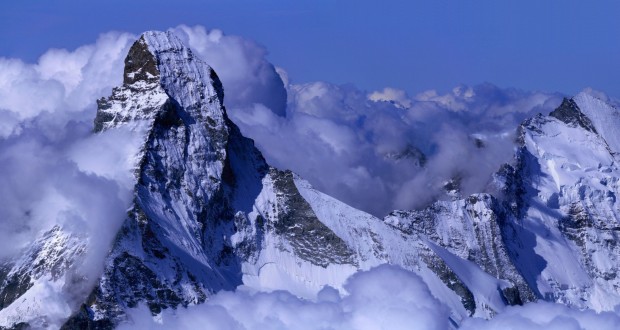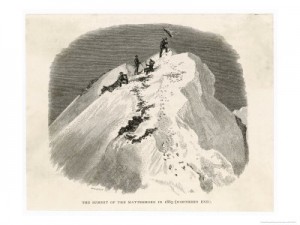Whymper and his party stayed about an hour on the summit and they began their decent. Croz descended first, then Hadow, Hudson, Douglas, Taugwalder father, Whymper and Taugwalder son coming last. They climbed down very carefully, with only one man moving at a time and all roped together. When they were barely an hour from the summit, a tragedy struck. Hadow slipped and fell on Croz who was in front of him. Unprepared Croz couldn’t withstand the shock and they both fell pulling down Hudson and Douglas. When hearing Croz’s shout, Whymper and Taugwalder quickly clasped the rocks but the rope broke. Whymper saw them slide down the slope, waving their hands convulsively trying to stop themselves but they kept falling from rock to rock until they finally disappeared over the edge.
Shocked and terrified Whymper fixed some ropes on firm rocks to secure themselves and continued the decent. When they finally reached a safer place on the ridge around 6 pm, they looked for traces for their companions and cried to them but couldn’t find them. Whymper saw a fog bow in the sky showing that the weather was changing, they continued to descent and found a resting place at 9:30 pm. They resumed their descent at daybreak and reached Zermatt on the morning of July 15. As soon as Whymper reached Zermatt, the rescue team started their ascend above the Zmutt valley. They returned after 6 hours and reported that they saw the bodies lying motionless on the snow. They propsed that the rescuers should leave on Sunday evening to arrive upon the plateau at daybreak on Monday. Whymper and J.M’Cormick decided to start on the rescue on Sunday morning but the guides of Zermatt said that if they couldn’t attend their early mass, they wouldn’t go. So other people came to help and offer their help.
At 8:30, Whymper and the other reached the top of the plateau. They soon discovered the bodies of Croz, Hadow and Hudson. For Douglas, they only found a pair of gloves, a belt and a boot. The bodies were left on the glacier. The bodies were recovered later on July 19 after an order of the administration. Croz, Hadow and Hudson were buried near the Church of Zermatt but Douglas’s body was never found and was thought to be lost somewhere on the north face.
After the accident, Whymper asked Taugwalder to see the rope and to his surprise, he saw that it was the oldest and the weakest rope they brought as a reserve. They soon realized that the fallen ones had been tied with the weaker rope and the survivor had been tied with a Manila rope, the stronger rope. Whymper then was accused of having betrayed his companions with the charge of responsibility. The guide Peter Taugwalder was accused, tried and acquitted. People believed that he cut the rope between him and Douglas to save his life. The controversy ensued whether the rope had been cut, but there was no proof to be found. The accident became a big news in Switzerland and abroad. Newspaper all over the world reported the tragedy.
Edward Whymper later wrote a book about his experience on the Matterhorn in the book called “Scrambles amongst the Alps”. You can view the broken rope of the first ascent at Matterhorn Museum.


